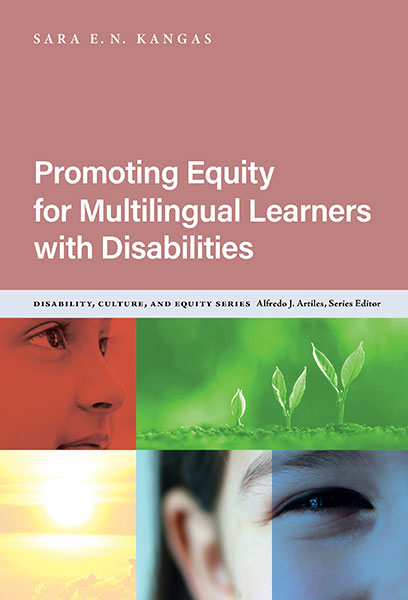Professors: Request an Exam Copy
Print copies available for US orders only. For orders outside the US, see our international distributors.
Publication Date: October 24, 2025
Pages: 240
Series: Disability, Culture, and Equity Series

This book examines the nature of equity for one of the most vulnerable populations of K–12 students—multilingual learners (MLs) with disabilities.
Drawing from a rich array of research and experiences as a teacher educator and policy consultant, the author demonstrates how MLs with disabilities encounter inequities in predictable, repeated ways throughout their schooling. Kangas establishes how these patterned inequities pervade education systems, school policies, and processes, ultimately stifling the learning opportunities and educational rights of students with intersecting language learning and disability needs.
Through concrete recommendations and helpful resources, the text empowers educators, researchers, and policymakers to detect and dismantle patterned inequities in their respective roles. This is an important guide for all stakeholders wishing to promote equitable learning and life opportunities for MLs with disabilities.
Book Features:
Sara E. N. Kangas is an associate professor and director of the special education and ESL programs in the College of Education at Lehigh University.
“Improving learning for every child is a daunting task, particularly if educators believe they are responsible only for particular kinds of learners. Sara Kangas’s new book reminds us that emancipatory policy must be geared to creating learning spaces that belong to all learners. To respond to the hybridity of today’s learners who bring complex needs, strengths, and capacities, we need policy conditions that promote and sustain learning cycles among and between educators and their students. Kangas addresses the need for educators to lean into the complexities that shape our brains, our hearts, and our futures.”
—Elizabeth B. Kozleski, faculty co-director, Learning Differences Initiative, Stanford Accelerator for Learning, Stanford University
“Dr. Kangas delivers a groundbreaking and deeply compassionate examination of the systemic barriers facing dually identified students—and offers clear, evidence-based solutions for educators committed to dismantling those barriers. This essential text empowers readers to take strategic, actionable steps, whether they work in the classroom or at the highest levels of policy.”
—Megan Hopkins, professor and chair, Department of Education Studies, UC San Diego
“In Promoting Equity for Multilingual Learners with Disabilities, Sara Kangas takes a historical perspective, denouncing the myths, deficit lenses, and dated theoretical approaches that continue to promote the systemic barriers multilingual learners (MLs) with disabilities experience. Dr. Kangas also offers a futuristic lens in the form of what she describes as ‘pathways forward,’ or concrete approaches, which district and school leaders and teachers can implement to ensure that bilingual and bicultural individuals with disabilities can learn without giving up any of their various and fluid identities. I trust that this book will incentivize new educational approaches located at the intersection of research and practice to continue to pursue inclusive and equitable experiences for our MLs with disabilities.”
—Patricia Martínez-Álvarez, associate professor of bilingual/bicultural education, Teachers College, Columbia University
“In Promoting Equity for Multilingual Learners With Disabilities, Sara Kangas provides a deeply thoughtful and necessary guide for those working to better support dually identified students, who too often fall through the cracks. With clarity and care, Kangas offers sharp analysis alongside the practical tools needed to build more inclusive, responsive systems where multilingual students with disabilities can truly thrive.”
—María Cioè-Peña, assistant professor, Educational Linguistics Division, University of Pennsylvania, Graduate School of Education
Contents
Preface xi
PART I: EQUITY FOUNDATIONS
1. Introduction 3
Demographic Overview of MLs With Disabilities 4
Inequities Experienced by MLs With Disabilities 6
Audiences of the Book 7
Structure and Features of the Book 7
A Few Thoughts 10
2. Patterned Inequities 11
Pattern One: Language-or-Disability Filter 11
Pattern Two: Unitary Identity 14
Pattern Three: Specialization Trap 16
Patterned Inequities Up Close: Disproportionality and Special Education Evaluation 18
Summary 24
PART II: EQUITY IN SYSTEMS
3. Organization of Services and Students 29
The Organization of Services and Students: Key Research Findings 30
Evidence of Patterns 33
Responses to Patterned Inequities in the Organizing of Services and Students 41
Summary 48
Recommended Resources 48
4. Individualized Plans and Teams 50
The Organization of Individualized Plans and Teams: Key Research Findings 51
Evidence of Patterns 54
Responses to Patterned Inequities in Individualized Plans and Teams 61
Summary 68
Recommended Resources 68
5. Teacher Education Programs and Professional Certifications 70
The Organization of Teacher Education Programs and Certifications: Key Trends 72
Evidence of Patterns 73
Responses to Patterned Inequities in Teacher Education Programs and Certifications 77
Summary 81
PART III: EQUITY IN CLASSROOMS
6. High Expectations 85
High Expectations: Key Research Findings 87
Evidence of Patterns 89
Responses to Patterned Inequities in Teacher Expectations 92
Summary 97
Recommended Resources 97
7. Rigorous Instruction 99
Rigorous Instruction: Key Research Findings 99
Evidence of Patterns 104
Responses to Patterned Inequities in Instruction 107
Summary 117
Recommended Resources 117
8. Sound Data Interpretation and Use 119
Sound Interpretation and Use of Data: Key Research Findings 120
Evidence of Patterns 122
Responses to Patterned Inequities in Data Use and Interpretation 125
Summary 129
PART IV: EQUITY IN POLICIES
9. Academic Standard Policies 133
Reclassification Policies: Key Research Findings 134
Evidence of Patterns 137
Responses to Patterned Inequities in Academic Standard Policies 143
Summary 150
10. State Policy Contexts 151
SEAs: Key Research Findings 152
Evidence of Patterns 153
Responses to Patterned Inequities in SEAs 156
Summary 165
Recommended Resources 166
PART V: CONCLUSION
11. Pathways Forward 169
Our Awareness 169
Our Response 172
Final Thoughts 181
Notes 183
References 185
Index 211
About the Author 225
Professors: Request an Exam Copy
Print copies available for US orders only. For orders outside the US, see our international distributors.